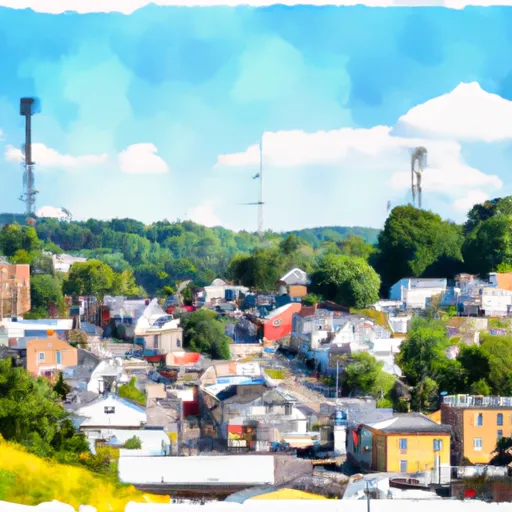-
 Snoflo Premium
Snoflo Premium
Get unlimited access to all our content
With no Ad interruptions! - Start Your Free Trial Login with existing account
Reynoldsville
Eden Index
Climate
8.7
•
Recreation
2.8
•
Community
1.5
•
Safeguard
4.8/10

Reynoldsville, Pennsylvania is a small borough located in Jefferson County. The climate in Reynoldsville is characterized by four distinct seasons. Summers are warm and humid, with average temperatures ranging from the mid-70s to the low 80s Fahrenheit. Winters are cold, with average temperatures in the mid-20s to low 30s Fahrenheit. The area experiences moderate rainfall throughout the year, with occasional snowfall during winter months.
Reynoldsville is surrounded by several water sources, including the Sandy Lick Creek and the Little Sandy Lick Creek. These hydrology constituents offer opportunities for fishing and water-based activities. Anglers can catch a variety of fish species, such as trout, bass, and catfish.
Outdoor enthusiasts can enjoy various recreational activities in Reynoldsville. The nearby Clear Creek State Forest provides opportunities for hiking, camping, and wildlife observation. The forest is home to an array of wildlife, including deer, turkey, and various bird species. Additionally, Reynoldsville is close to the 40-mile long Redbank Valley Trail, which offers opportunities for biking, walking, and horseback riding.
Overall, Reynoldsville, Pennsylvania provides a pleasant climate, access to water sources, and diverse outdoor recreational opportunities for nature enthusiasts.
What is the Eden Index?
The Snoflo Eden Index serves as a comprehensive rating system for regions, evaluating their desirability through a holistic assessment of climate health, outdoor recreation opportunities, and natural disaster risk, acknowledging the profound impact of these factors on livability and well-being.
Climate Health Indicator (CHI): 8.7
Reynoldsville receives approximately
1112mm of rain per year,
with humidity levels near 79%
and air temperatures averaging around
9°C.
Reynoldsville has a plant hardyness factor of
5, meaning
plants and agriculture in this region thrive during a short period during spring and early summer. Most
plants will die off during the colder winter months.
By considering the ideal temperature range, reliable water supplies, clean air, and stable seasonal rain or snowpacks, the Climate Health Indicator (CHI) underscores the significance of a healthy climate as the foundation for quality living.
A healthy climate is paramount for ensuring a high quality of life and livability in a region, fostering both physical well-being and environmental harmony. This can be characterized by ideal temperatures, reliable access to water supplies, clean air, and consistent seasonal rain or snowpacks.
Weather Forecast
Streamflow Conditions
Allegheny
Area Rivers
Allegheny
Snowpack Depths
Allegheny
Reservoir Storage Capacity
Allegheny
Groundwater Levels
Recreational Opportunity Index (ROI): 2.8
The Recreational Opportunity Index (ROI) recognizes the value of outdoor recreational options, such as parks, hiking trails, camping sites, and fishing spots, while acknowledging that climate plays a pivotal role in ensuring the comfort and consistency of these experiences.
Access to outdoor recreational opportunities, encompassing activities such as parks, hiking, camping, and fishing, is crucial for overall well-being, and the climate plays a pivotal role in enabling and enhancing these experiences, ensuring that individuals can engage in nature-based activities comfortably and consistently.
Camping Areas
| Campground | Campsites | Reservations | Toilets | Showers | Elevation |
|---|---|---|---|---|---|
| Nanty Glo Municipal Park | None | 1,733 ft | |||
| Clear Creek State Park | None | 1,322 ft | |||
| Duman Lake County Park | 6 | 1,743 ft | |||
| Lorain Borough Park | None | 1,316 ft | |||
| Twin Lakes Rec Area | 211 | 1,760 ft | |||
| Quemahoning Family Rec Area | 63 | 1,668 ft | |||
| Loleta Rec Area | 89 | 1,350 ft | |||
| Red Mill | 10 | 1,524 ft | |||
| Tracy Ridge Rec Area | 119 | 2,232 ft | |||
| Adams Croyle | None | 1,688 ft |
Nearby Ski Areas
Catastrophe Safeguard Index (CSI):
The Catastrophe Safeguard Index (CSI) recognizes that natural disaster risk, encompassing floods, fires, hurricanes, and tornadoes, can drastically affect safety and the overall appeal of an area.
The level of natural disaster risk in a region significantly affects safety and the overall livability, with climate change amplifying these risks by potentially increasing the frequency and intensity of events like floods, fires, hurricanes, and tornadoes, thereby posing substantial challenges to community resilience and well-being.
Community Resilience Indicator (CRI): 1.5
The Community Resilience Indicator (CRI) recognizes that education, healthcare, and socioeconomics are crucial to the well-being of a region. The CRI acknowledges the profound impact of these elements on residents' overall quality of life. By evaluating educational resources, healthcare accessibility, and economic inclusivity, the index captures the essential aspects that contribute to a thriving community, fostering resident satisfaction, equity, and social cohesion.

